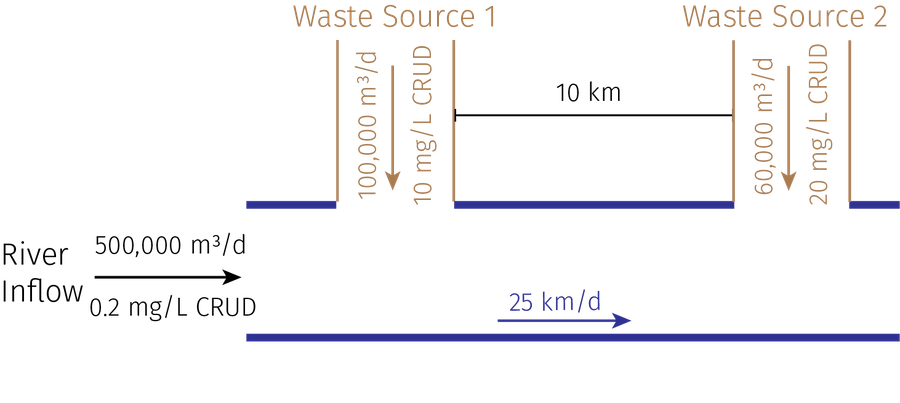class: center, middle .title[Prescriptive Modeling and Waste Load Allocation] <br> .subtitle[BEE 4750/5750] <br> .subtitle[Environmental Systems Analysis, Fall 2022] <hr> .author[Vivek Srikrishnan] <br> .date[September 19, 2022] --- name: toc class: left # Outline <hr> 1. Questions? 2. Prescriptive Modeling 3. Waste Load Allocation Problems --- name: poll-answer layout: true class: left # Poll <hr> .left-column[{{content}} URL: [https://pollev.com/vsrikrish](https://pollev.com/vsrikrish) Text: **VSRIKRISH** to 22333, then message] .right-column[.center[]] --- name: questions template: poll-answer ***Any questions?*** --- layout: false # Last Class <hr> * Fate and Transport Modeling * Dissolved Oxygen * Simulation Workflow --- class: left # CRUD, Revisited <hr> .center[] Recall the CRUD wastewater model from [Lecture 2](https://viveks.me/environmental-systems-analysis/assets/lecture-notes/02-intro-modeling/index.html#13). --- class: left # CRUD, Revisited <hr> .center[] Environmental authorities have sampled water from the river and determined that concentrations exceed the legal standard (1 mg/L). --- class: left # CRUD, Revisited <hr> .center[] We want to design a CRUD removal plan to get back in compliance. --- class: left # Prescriptive Modeling <hr> If we want to design a treatment strategy, we are now in the world of *prescriptive modeling*. **Recall**: Precriptive modeling is intended to specify an action, policy, or decision. -- * Descriptive modeling question: "What happens if I do something?" * Prescriptive modeling question: "What should I do?" --- class: left # Decision Model Components <hr> This means that we need a *decision model*. What information do we need to specify a decision? --- class: left # Components of a Decision Model <hr> **Objective**: What are we trying to *do*? * *e.g* minimizing cost or impact **Constraints**: What limits do we have to observe? * *e.g.* budgetary or regulatory constraints --- class: left # Decision Model for CRUD Treatment <hr> Let's apply this framework to the CRUD release problem. * What might our objective be? * What constraints do we have? --- class: left # Formulating An Objective <hr> .center[] Let's say that our objective is to minimize costs, and relevant constraints include the regulatory standard. --- class: left # Formulating An Objective <hr> .center[] Treating CRUD costs $ \$50 E^2 \text{ per } 1000 \ m^3,$ where $E$ is the treatment efficiency. --- class: left # Formulating An Objective <hr> .center[] This makes the treatment cost $$ C(E_1, E_2) = 50(100)E_1^2 + 50(60)E_2^2 = 5000E_1^2 + 3000E_2^2. $$ --- class: left # Formulating An Objective <hr> Treatment Cost: :$ :C (E*1, E*2) = 50(100)E*1^2 + 50(60)E*2^2 = 5000E*1^2 + 3000E*2^2.:$ Then the objective is to minimize the cost, or $$ \min_{E_1, E_2} 5000E_1^2 + 3000E_2^2. $$ --- class: left # Developing Constraints <hr> But we can't choose just any $E_1$ and $E_2$ to minimize the cost, or we would just choose $E_1=E_2=0$. -- For example, we need to comply with the regulatory standard: CRUD concentration $< 1$ mg/l. --- class: left # Developing Constraints <hr> **What information can we bring to bear?** -- Since we know that the concentrations are highest at the points of discharge, we can check whether each of those points is in compliance with the standard. --- class: left # Mass Balance at Point 1 <hr> .center[] Total CRUD after factory 1 release: $\color{blue}\text{100} + \color{red} 1000(1-E_1) \color{black} \ \text{kg/d}$ --- class: left # Mass Balance at Point 1 <hr> .center[] Our standard is $1 \ \text{mg/L} = 10^{-3} \ \text{kg/m}^3$, and the volume of the inflow is $\color{blue}500,000 + \color{red}100,000 \color{black}= 600,000 \ \text{m}^3\text{/d}$. --- class: left # Constraint at Point 1 <hr> So: $$ \begin{aligned} 100 + 1000(1-E_1) &\leq 600 \\\\ \color{blue}1000E_1 &\color{blue}\geq 500 \end{aligned} $$ --- class: left # Mass Balance at Release 2 <hr> .center[] We [had derived](https://viveks.me/environmental-systems-analysis/assets/lecture-notes/02-intro-modeling/index.html#31) that the CRUD concentration at release 2 is: $$ (1100 - 1000E_1) \exp(-0.18) + 1200(1 - E_2) \ \text{kg/d}. $$ --- class: left # Mass Balance At Release 2 <hr> .center[] The volume at release 2 is $660,000 \ \text{m}^3\text{/d}$, so the constraint is: $$ (1100 - 1000E_1) \exp(-0.18) + 1200(1 - E_2) \leq 660. $$ --- class: left # Constraint At Release 2 <hr> Simplifying: $$ \begin{aligned} (1100 - 1000E_1) \exp(-0.18) + 1200(1 - E_2) &\leq 660 \\\\ (1100 - 1000E_1) 0.835 + 1200(1 - E_2) &\leq 660 \\\\ 2119 - 835E_1 - 1200E_2 &\leq 660\\\\ \color{blue} 835E_1 + 1200E_2 &\color{blue}\geq 1459 \end{aligned} $$ --- class: left # Model Formulation <hr> Combining our objective and our regulatory constraints: $$ \begin{alignat}{3} & \min_{E_1, E_2} &\color{green}\quad 5000E_1^2 + 3000E_2^2 & \notag \\\\ & \text{subject to:} & \color{blue}1000 E_1 &\color{blue}\geq 500 \notag \\\\ & & \color{blue}835E_1 + 1200E_2 &\color{blue}\geq 1459 \notag \\\\ \end{alignat} $$ -- **Is this complete?** --- class: left # Model Formulation <hr> $$ \begin{alignat}{3} & \min_{E_1, E_2} &\color{green}\quad 5000E_1^2 + 3000E_2^2 & \\\\ & \text{subject to:} & \color{blue}1000 E_1 &\color{blue}\geq 500 \\\\ & & \color{blue}835E_1 + 1200E_2 &\color{blue}\geq 1459 \\\\ & & \color{purple}E_1, E_2 &\color{purple}\geq 0 \\\\ & & \color{purple}E_1, E_2 &\color{purple}\leq 1 \end{alignat} $$ --- class: left # Ok...so how do we solve this? <hr> More general discussion next time, but this example is relatively straightforward to solve graphically. --- class: left # Plot the Decision Space <hr> .left-column[ ```julia using Plots using LaTeXStrings using Measures # define objective function a = range(0, 1, step=0.05) b = range(0, 1, step=0.05) f(a, b) = 5000 * a.^2 + 3000 * b.^2 # plotting contours contour(a,b,(a,b)->f(a,b), nlevels=15, c=:heat, linewidth=5, colorbar = false, contour_labels = true, grid = false, right_margin=8mm) xaxis!(L"E_1", ticks=0:0.1:1, limits=(0, 1)) yaxis!(L"E_2", ticks=0:0.1:1, limits=(0, 1)) ``` ``` "/private/var/folders/24/8k48jl6d249_n_qfxwsl6xvm0000gn/T/jl_DW9KSa/build/crud-base-plot.svg" ``` ] .right-column[] --- class: left # Plot the Feasible Region <hr> .left-column[ ```julia # plot constraints vline!([0.5], color=:green, linewidth=3, label=false) # Equation 2 plot!(a, (1459 .- 835 .* a) ./ 1200, color=:green, linewidth=3, label=false) # Equation 3 # plot feasible region fa = a[a .>= 0.5] fb = (1459 .- 835 .* a[a .>= 0.5])./1200 plot!(fa, fb, fillrange=1, label="Feasible Region", opacity=0.4, color=:green, legend=:bottomleft) scatter!([0.5], [(1459 - 835 * 0.5) / 1200], markershape=:star, color=:yellow, markersize=20, label="Optimum") ``` ``` "/private/var/folders/24/8k48jl6d249_n_qfxwsl6xvm0000gn/T/jl_DW9KSa/build/crud-feasible-plot.svg" ``` ] .right-column[ ] --- class: left # The Solution! <hr> .left-column[So the solution occurs at the intersection of the two constraints, where: $$ E_1 = 0.5, E_2 = 0.85 $$ and the cost of this treatment plan is $$ C(0.5, 0.85) = \$ 3417. $$ **Does this solution make sense**? ] .right-column[ ] --- class: left # Waste Load Allocation Problems <hr> .center[] This is an example of a *waste load allocation* problem. --- class: left # Waste Load Allocation Problems <hr> .center[] **Key question**: How do we restrict waste discharges to control or limit environmental impact? --- center: left # Waste Load Allocation Problems <hr> .center[] Each source is allocated a "load" they can discharge based on waste fate and transport. --- class: left # Waste Load Allocation Problem <hr> Waste loads affect quality $Q$ based on F&T model: $$ Q=f(W_1, W_2, \ldots, W_n) $$ -- So the general form for a prescriptive waste load allocation model: $$ \begin{aligned} \text{determine} & \quad W_1, W_2, \ldots, W_n \notag \\\\ \text{subject to:} & \quad f(W_1, W_2, \ldots, W_n) \geq Q^* \notag \end{aligned} $$ -- How do we choose certain variables to **optimize** a target outcome, possibly subject to some constraints. --- class: middle, center <hr> # Next Class <hr> * Optimization Models * Solution Methods * Solving the CRUD Example